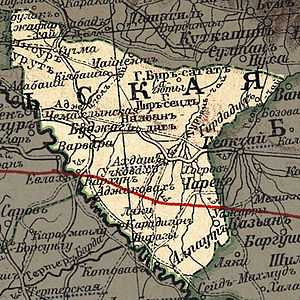Areshsky Uyezd
| Areshsky Uyezd (English) Арешский уезд (Modern Russian) | |
|---|---|
 | |
| Coat of Arms | |
 Coat of arms of Elisabethpol Governorate | |
| Established | 1874 |
| Abolished | 1929 |
| Political status Region |
Uyezd Caucasus |
| Area | |
| Area - Rank |
2,822.9 verst² n/a |
| Population (1897 census) | |
| Population - Rank - Density - Urban - Rural |
67,277 inhabitants n/a 23.8 inhab. / verst² |
| Government | |
| First Head Last Head | n/a n/a |
Areshsky Uyezd (Russian: Арешский уезд) was one of the uyezds (administrative units) of Elisabethpol Governorate of the Russian Empire and then of Azerbaijan Democratic Republic with its center in Agdash from 1874[1] until its formal abolition in 1929 by Soviet authorities.[2][3]
Geography
Elisabethpol Governorate consisted of Elisabethpol, Nukha, Shusha, Zangezur, Kazakh, Areshsky, Jabrayil and Javanshir Uyezds.[4] Aresh uyezd was located in the northeastern part of Elisabethpol Governorate, on the banks of Kura River, bordering Baku Governorate on the east, Nukhinsky Uyezd on the north, Elisabethpol Uyezd on the west and Shusha Uyezd on the southwest. The area of the uyezd was 2822.9 square verst. The territory of the uyezd was mainly made up of lowlands.[5] The uyezd center was first in Uchkovakh, then in Agdash which was considered the largest cotton-trading center in the lowlands of Transcaucasus.[3]
History
The territory of Areshky Uyezd was located in the Turyanchay River basin. The area was called Aresh (Azerbaijani: Ərəş) in the Middle Ages and was a part of Shirvan Baylarbaylik which significantly weakened after repeated Ottoman - Safavid wars, and was eventually subdued by Shaki Khanate in 1750's. After establishment of Russian rule, Aresh was a part of Nukhinskiy Uyezd of Baku Governorate. In 1874, the territory was transferred into a separate Areshsky Uyezd of newly established Elisabethpol Governorate (1868). It was abolished by Soviet authorities in 1929 and a new Agdash Rayon was established in its place in 1930.[6]
Population
According to census held in 1897, the population of uyezd was 67,277, of which 47,133 were Azerbaijani Turks, 13,822 were Armenians, 162 - Russians, and other minorities.[7][8] The population was engaged primarily in agricultural farming and gardening. During summers, they would take the cattle to the mountains and return only in September. Wool production played an important role in the economy of uyezd.[5]
References
- ↑ Agaian, Tshatur (1956). Крестьянская реформа в Азербайджане в 1870 году [Peasant reforms in Azerbaijan in 1870]. Baku, Azerbaijan: National Academy of Sciences of Azerbaijan SSR. p. 61. Retrieved 2013-04-09.
- ↑ Chisholm, Hugh (1910). The Encyclopædia britannica: a dictionary of arts, sciences, literature and general information. Volume 9. Leiden, the Netherlands: The Encyclopædia Britannica Company. p. 280. ISBN 978-90-04-17901-1. Retrieved 2011-08-04.
- ↑ 3.0 3.1 "Большой энциклопедический словарь Брокгауза и Ефрона. Агдаш" [Brockhaus and Efron Encyclopedia Dictionary. Agdash]. Retrieved 2011-08-05.
- ↑ "Административно-территориальные реформы на Кавказе в середине и во второй половине ХIХ века" [Administrative-territorial reforms in Caucasus in middle and second half of 19th century]. Retrieved 2011-08-05.
- ↑ 5.0 5.1 "Большой энциклопедический словарь Брокгауза и Ефрона. Арешский уезд" [Brockhaus and Efron Encyclopedia Dictionary. Areshsky Uyezd]. Retrieved 2011-08-05.
- ↑ Khalafov, M.S. (1964). История государства и права Азербайджанской ССР [History of State and Law of Azerbaijan SSR] 1. Baku, Azerbaijan: National Academy of Sciences of Azerbaijan SSR. Institute of Philosophy and Law. p. 46. Retrieved 2013-04-09.
- ↑ "Первая всеобщая перепись населения Российской Империи 1897 г. Распределение населения по родному языку и уездам Российской Империи кроме губерний Европейской России" [First All Russian Imperial Census of 1897. Population split according to languages spoken; uyezds of Russian empire except for governorates in European part of empire]. Retrieved 2013-04-09.
- ↑ "АРЕШСКИЙ УЕЗД (1897 г.)" [Areshskiy Uyezd (1897)]. Retrieved 2011-08-05.